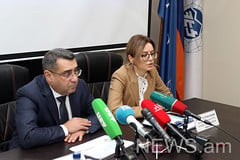
The Swedish portal Blankspot was provided with documents that give a unique insight into how the negotiations took place in the aftermath of the 44-day war in Nagorno-Karabakh during the time of Ann Linde as chairman of the OSCE. Among other things, they show that the allocation of additional resources to reach a peace agreement was not a priority.
Earlier, the portal wrote about the cooperation of the Swedish Ministry of Foreign Affairs with ISDP, a research institute receiving money from Azerbaijan. This cooperation took place when Foreign Minister Ann Linde served as OSCE Chairperson in 2021 and was responsible for initiating peace talks between Armenia and Azerbaijan following the 2020 Nagorno-Karabakh war.
Blankspot has reviewed publicly available documents reflecting the initial peace talks between Armenia and Azerbaijan following the Nagorno-Karabakh war.
Approximately 75-80% of the documents are classified, and the rest of them were edited after checking the secrecy in the Foreign Ministry. Despite this, documents show intense negotiations and the presence of Swedish Foreign Minister Ann Linde at the initial peace talks between the warring parties.
At the same time, the Ministry of Foreign Affairs gave money to the research institute ISDP, which has far-reaching ties with Azerbaijan.
In a dossier sent to the MFA registrar, Blankspot requested all correspondence with accompanying attachments between MFA officials for the OSCE chairmanship and Armenia and Azerbaijan, as well as correspondence with the Minsk Group chair countries (Russia, France and the United States).
In response, Blankspot received 6 documents:
1. E-mail correspondence with the American delegation of the Minsk Group on November 2, 2020, a week before the signing of the ceasefire statement.
2. Briefing for Ann Linde from the Minsk Group on November 12, 2020, three days after the ceasefire.
3. Briefing by the Ambassador of Sweden to Azerbaijan at the Ministry of Foreign Affairs on November 25, 2020. This was before the Swedish chairmanship of the OSCE.
4. Summary of Ann Linde's visit to Azerbaijan on March 14-15, 2021, when the OSCE was supposed to initiate peace talks.
5. Summary of Ann Linde's visit to Armenia on March 16, 2021 for the same purpose.
6. Summary of Ann Linde's talks with the ambassadors of Armenia and Azerbaijan on the continuation of peace talks, 13 May 2021.
In short, the documents reveal trust issues between the warring parties and the OSCE, as well as differing views on such important issues as the status of Armenian prisoners of war. The data also shows that the OSCE considers Russia's presence in Nagorno-Karabakh to be consistent with the previous 2009 peace talks (Madrid Principles).
In addition, the documents serve as a timeline of how the initial peace talks developed within the OSCE.
The first document relating to the final stages of the war (November 2, 2020) states that Sweden has started negotiations with the co-chairs of the Minsk Group (France, Russia and the United States) and the Personal Representative of the OSCE Chairman Andrzej Karspzyk. The latter acted as the closest adviser to Ann Linde during the OSCE chairmanship.
It appears from the correspondence that the American co-chair Andrew Schofer wanted to make sure that Ann Linde during the Swedish chairmanship would stick to the same line as the Minsk Group had up to this point.
Among other things, the issue of a Scandinavian peacekeeping force instead of a Russian one was raised. The American co-chair of the Minsk Group stressed that Russia plans to deploy its own peacekeeping contingents. The United States preferred to find alternatives, or at least be able to offer them in the long run.
It also appears that the United States was disappointed that three previous ceasefire attempts during the war were quickly thwarted. The US delegate states that they believe Armenia wants an immediate ceasefire for humanitarian operations, while the Azerbaijani side does not want a ceasefire until a package agreement on "substantial negotiations" is concluded.
The US delegate also called it "ridiculous" to continue negotiations on a ceasefire when the warring parties did not follow what they had already agreed to.
In addition, it appears that both warring parties wanted to increase the budget for the OSCE's efforts in the peace talks to ensure that more confidence-building measures are taken. The representative of Sweden rejected the request.
Finally, Karspzyk criticizes both sides for not being afraid of the fact that the war threatens the "existence of the OSCE".
On November 12, three days after the signing of a ceasefire agreement between Armenia and Azerbaijan with Russian help, Ann Linde requested a briefing from the Minsk Group.
The American co-chair said at a briefing that it is useless to start peace talks between the parties until they are "genuinely" ready to take this step. Surprisingly, it is also noted that the parties have several points in common, although these points are confidential.
The document notes that the deployment of Russian peacekeeping forces is in line with the 2009 Madrid Principles agreed within the framework of the OSCE. One of the points was that Nagorno-Karabakh would be guarded by international troops until a referendum on the status of the region was held.
The document says that the idea of a Scandinavian peacekeeping force was abandoned. This is mainly due to the fact that, as Ann Linde notes, "Sweden is not neutral, it is non-aligned”. In addition, she adds "we would need to carefully consider any future inquiries – a process that requires time."
It is noted that the role of Ann Linde as OSCE Chairperson is to coordinate the implementation of the field presence with the participating States and initiate peace negotiations.
The November 25 email correspondence, in which Swedish Ambassador to Azerbaijan Christian Camille describes his preparatory meetings, is almost entirely confidential. The only thing that is clear is that he met with assistant Mehriban Aliyeva, who is also the wife of President Ilham Aliyev, and vice president. This indicates that Azerbaijan is curious about what Sweden's position will be during its forthcoming OSCE chairmanship.
The statements of Azerbaijan on March 14-15 and those of Armenia on March 16 are more complete. Previous documents indicated that the OSCE was not going to meet with the parties unless they were sincerely interested in negotiations, and Ann Linde's visits to countries led to the first such high-level talks since the war.
Ann Linde met with the top leadership and foreign ministers of both countries.
The meeting with Ilham Aliyev in Azerbaijan was held in "good spirits," writes Ambassador Christian Camille. Much of the text is confidential, but Ann Linde emphasizes that the Minsk Group format is suitable for "facilitating" peace efforts.
In addition, Ann Linde touched upon the issue of the treatment of prisoners of war, which was one of the most acute problems of the post-war period.
Shortly after the war, Armenia handed over all the prisoners of war to Azerbaijan, and up to 200 Armenians remained in Azerbaijani captivity. Several human rights organizations, including Human Rights Watch, have accused Azerbaijan of failing to comply with the rules regarding prisoners of war. At a meeting with Ilham Aliyev, Ann Linde emphasizes the importance of their return in accordance with international law.
The documents also state that in a subsequent press conference the next day with Azerbaijani Foreign Minister Jeyhun Bayramov, Ann Linde raised the issue again, but Bayramov took the floor and stated that the Armenians were captured after November 10, so they are not considered prisoners of war. .
The way Ilham Aliyev discussed this issue in a conversation with Ann Linde is confidential. However, from the video recording of the conversation between the Aliyevs and the Erdogans, it became known that the prisoners of war were considered a good trump card against Armenia.
Since then, there have been several exchanges of prisoners of war in exchange for Armenia providing Azerbaijan with a map of minefields.
Since then, Ann Linde, like the International Committee of the Red Cross, has referred to prisoners of war as "prisoners". However, the Red Cross has indicated that the status of the prisoners must be resolved between Azerbaijan and Armenia and is ready to ensure a safe transfer. The difference between the status of "prisoner" and "prisoner of war" is whether the detainee is subject to the provisions of the Geneva Conventions.
From the documents of the March 16 meetings in Armenia, it appears that Ann Linde, in addition to meetings with Prime Minister Nikol Pashinyan and then Foreign Minister Ara Ayvazyan, also held a brief informal and undocumented meeting with representatives of Stepanakert.
In a conversation with the Minister of Foreign Affairs, the importance of adding additional resources to the peace negotiations was emphasized, which was also announced on November 2, 2020 and then rejected by the Swedish delegation. Ayvazyan also stressed the fear of the resumption of a full-scale war, which could lead to a new Armenian genocide.
During the conversation with Pashinyan, he again raised the issue of prisoners of war, and also expressed the hope that the Swedish chairmanship in the OSCE would contribute to the final settlement of the conflict, taking into account the status of Nagorno-Karabakh.
Ayvazyan also expressed concern that the Armenian cultural heritage is under threat from Azerbaijan in the large territories seized by Baku.
As Blankspot reports, those fears came true in February 2022. And this despite the fact that the issue was raised at the International Court of Justice in The Hague.
Finally, Ann Linde emphasized that a final peace agreement was not Sweden's priority during the OSCE chairmanship, but rather stated that the ceasefire was respected.
Here is what is written in the documentation: “Sweden’s priorities within the presidency were mentioned. The ceasefire agreement was only such, not a final peace agreement. Here, the OSCE could contribute with further conflict resolution efforts.”
The latest document dated May 13, 2021 states that Linde called for relevant meetings with the foreign ministers of Armenia and Azerbaijan. The reason is reports of Armenia accusing Azerbaijan of invading the Armenian region of Syunik on May 12.
While the Armenian foreign minister highlighted the importance of the world community distancing itself from Azerbaijan's actions, the Azerbaijani foreign minister argues that the borders are not clear after the 2020 war.
Blankspot asked the Ministry of Foreign Affairs about priorities during the presidency of the OSCE. An email to press secretary Ann Linde mentions reports that the budget has not changed despite the war and that Linde, during her visit to Armenia, announced that a ceasefire is taking precedence over a peace deal.
The Ministry of Foreign Affairs responded as follows: "Sweden and the EU welcomed the ceasefire between Armenia and Azerbaijan as it put an end to the fighting. However, the ceasefire was only a first step towards a peace agreement. During the Swedish Presidency, the work for the parties to take further steps towards a peace agreement was a high priority. It was hard work shortly after an armed conflict with many dead and with great human suffering. The Minsk Group and the Presidency’s personal representative have made efforts to move the process forward."






















